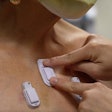
A new biosensor features superhydrophobic material that measures sweat vapor on a human body without absorbing water.
The sensor, described recently in ACS Nano, could be developed as a diagnostic tool to detect various health conditions, according to the authors.
Human sweat comes in two different forms; both contain biomarkers that can assist doctors in making health diagnoses.
Sensible, or liquid, perspiration is sweat that can be sensed by the perspiring person, particularly during hot weather or intensive exercise. Wearable sensors can currently provide continuous, noninvasive tracking of this type of sweat. They can be used to monitor a person's perspiration rate and provide information about their skin, nervous system, and underlying health conditions.
By contrast, insensible, or vapor, perspiration is secreted at a much lower rate during low-intensity exercise or rest, and is not perceived by the person emitting the vapor. Measuring this secretion of water vapor from the skin with current sensors is challenging. Skin-interfaced devices that detect sweat rate and loss are currently limited to working exclusively with sensible sweat. However, monitoring insensible sweat can be a useful tool in evaluating skin health and diseases, including eczema and wound healing, as well as underlying health conditions, such as pain and anxiety.
In the ACS Nano study, the researchers developed a superhydrophobic sweat sensor prototype to measure vapor from insensible perspiration. The material -- a superabsorbent hydrogel composite on a porous substrate sandwiched between two superhydrophobic textile layers -- allows the permeation of sweat vapor only, while preventing the sensor from being affected by the external water droplets excreted during sensible perspiration. This allows the biosensor to continuously measure sweat vapor from insensible sweat with a high degree of sensitivity and rapid response.
The researchers conducted proof-of-concept demonstrations on human subjects, showcasing the sensor's feasibility to continuously evaluate the body’s thermoregulation and skin barrier functions. They say the sensor could be integrated with a flexible wireless communication and powering module to continuously monitor sweat rates at different body locations.
“This enables the assessment of thermal comfort, disease conditions, and nervous system activity,” co-author Huanyu Cheng, an associate professor of engineering science and mechanics at the Pennsylvania State University, said in a statement. "It provides a low-cost device platform to detect other health-relevant biomarkers in the sweat vapor as the next-generation sweat sensor for smart healthcare and personalized medicine.”



















